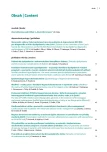Remarks on biomarkers of cardiovascular risk
Authors:
Janka Franeková 1,2; Antonín Jabor 1,2
Authors‘ workplace:
Pracoviště laboratorních metod IKEM, Praha
1; Ústav laboratorní diagnostiky 3. LF UK, Praha
2
Published in:
Vnitř Lék 2018; 64(1): 72-76
Category:
Reviews
Overview
Authors describe state-of-the-art in the routine laboratory diagnostics of cardiovascular risk with special emphasis on metrology, traceability, external quality assessment, biological variation, and reference change value. While analytical quality of total cholesterol, triglycerides, glucose, and HbA1c is satisfactory, improvements are needed for HDL-cholesterol, LDL-cholesterol, apolipoprotein A1, apolipoprotein B, Lp(a), and LpPLA2 measurements. Biological variation is a strong player in the lipid diagnostics, because reference change value is above 20 % for majority of biomarkers. Current methodology for the measurement of remnant cholesterol is far from optimum and standardization is therefore needed.
Key words:
biological variation – clinical chemistry – interpretation – lipid profile – metrology – remnant cholesterol
Sources
1. Nordestgaard BG, Langsted A, Mora S et al. Fasting is not routinely required for determination of a lipid profile: clinical and laboratory implications including flagging at desirable concentration cut-points-a joint consensus statement from the European Atherosclerosis Society and European Federation of Clinical Chemistry and Laboratory Medicine. Eur Heart J 2016; 37(25): 1944–1958. Dostupné z DOI: <http://dx.doi.org/10.1093/eurheartj/ehw152>.
2. Soška V, Franeková J, Friedecký B et al. Společné stanovisko českých odborných společností ke konsensu European Atherosclerosis Society a European Federation of Clinical Chemistry and Laboratory Medicine k vyšetřování krevních lipidů a k interpretaci jejich hodnot. Klin Biochem Metab 2017; 25(1): 36–42.
3. Langsted A, Freiberg JJ, Nordestgaard BG. Fasting and nonfasting lipid levels: influence of normal food intake on lipids, lipoproteins, apolipoproteins, and cardiovascular risk prediction. Circulation 2008; 118(20): 2047–2056. Dostupné z DOI: <http://dx.doi.org/10.1161/CIRCULATIONAHA.108.804146>.
4. Mora S, Rifai N, Buring JE et al. Fasting compared with nonfasting lipids and apolipoproteins for predicting incident cardiovascular events. Circulation 2008; 118(10): 993–1001. Dostupné z DOI: <http://dx.doi.org/10.1161/CIRCULATIONAHA.108.777334>.
5. Franeková J, Jabor A, Soška V. Vliv standardní zátěže tukem na koncentrace triacylglycerolů a HDL cholesterolu. FONS 2016; 26(3)3 : 22–24.
6. Varbo A, Nordestgaard BG. Remnant lipoproteins. Curr Opin Lipidol 2017; 28(4): 300–307. Dostupné z DOI: <http://dx.doi.org/10.1097/MOL.0000000000000429>.
Labels
Diabetology Endocrinology Internal medicineArticle was published in
Internal Medicine

2018 Issue 1
Most read in this issue
- Familial combined hyperlipidemia – the most common genetic dyslipidemia in population and in patients with premature atherothrombotic cardiovascular disease
- Epidemiology of hypercholesterolemia
- Diabetic dyslipidemia and microvascular complications of diabetes
- The current position of hydrochlorothiazide among thiazide and thiazide-like diuretics
